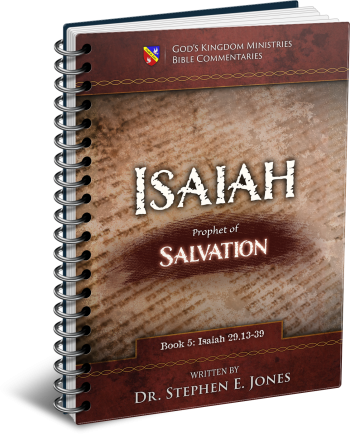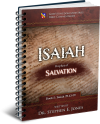Latest Posts
View the latest posts in an easy-to-read list format, with filtering options.

Isaiah is the prophet of Salvation. He is also known as the truly "Universalist" prophet, by which is meant that He makes it clear that salvation is extended equally to all nations and not just to Israel. He lived to see the fall of Israel and the deportation of the Israelites to Assyria, and he prophesied of their "return" to God (through repentance). He is truly a "major prophet" whose prophecies greatly influenced the Apostle Paul in the New Testament.
Category - Bible Commentaries

The final verses of Isaiah 30 give us a prophecy of deliverance. In the immediate context, this end-time deliverance was foreshadowed by God’s deliverance of Jerusalem after Hezekiah appealed to God for help. That deliverance established a precedent for a greater deliverance in our time from the rule of the nations in general.
Isaiah 30:27 begins,
27 Behold, the name of the Lord comes from a remote place; burning is His anger and dense is His smoke; His lips are filled with indignation and His tongue like a consuming fire.
God’s “name” in this case (Hebrew: shem) refers to His power and ability to judge Assyria. In that it “comes from a remote place,” the prophet suggests both a distant place and a distant time when this was to be fulfilled.
As for the deliverance itself, the prophet uses vivid metaphors of fire and smoke, calling to mind one of the main reasons for the judgment itself. The valley of Ben-hinnom (or Gehenna) on the southwest side of Jerusalem was the place where Judah had often offered their first-born sons to Moloch in specially-made furnaces called Tophet. Hence, by the law of equal measure, “burn for burn” in Exodus 21:25, God was judging their fire with Holy Spirit fire.
Such baby sacrifice was seen as the cause of Jerusalem’s utter destruction again in Jer. 19:2, 4-6, 10, 11.
The prophet also tells us that His tongue is a consuming fire. In Hebrew thought, the tongue was seen as a spear or sword. A judge’s tongue in particular was a fiery sword, because his verdicts were rendered according to God’s “fiery law” (Deut. 33:2, KJV) which also reflected God’s nature as the all-consuming fire (Deut. 4:24).
Isaiah 30:28 continues,
28 His breath is like an overflowing torrent which reaches to the neck, to shake the nations back and forth in a sieve, and to put in the jaws of the peoples the bridle which leads to ruin [ta’ah, “to err, wander, stagger”].
The metaphor here seems to picture a river of fire that “is like an overflowing torrent which reaches to the neck.” As we might say today, the people being judged are up to their necks in trouble. The river of fire is again featured in Dan. 7:10, picturing the Great White Throne from whence this fire flows.
The fire is the law of God, which judges the people as they are summoned from their graves. The sentence is then carried out in that age of judgment, where the river becomes a “lake of fire” (Rev. 20:14, 15).
A second metaphor that the prophet uses is that the people are separated “in a sieve.” This was another way of saying that the nations were to be judged, but not all in the same manner. Everyone is to be judged according to their works, because the law is just.
Jesus set forth this separation in Matt. 25:32,
32 All the nations will be gathered before Him; and He will separate them from one another, as the shepherd separates the sheep from the goats.
Whereas Isaiah pictures a sieve separating grain from its impurities, Jesus pictured a shepherd separating sheep from goats. In either case the nations are separated into different categories for judgment. We should also note that the purpose of a sieve is not to destroy grain but to cleanse it by washing away impurities. Likewise, the purpose of separating sheep from goats is not to destroy either but to show the difference between believers and unbelievers.
Unbelievers must undergo judgment in that age in order to learn righteousness (Isaiah 26:9).
Isaiah also speaks of putting a bridle on the jaws of the people, “which leads to ruin.” The prophet was showing the sovereignty of God here. God is able to put a bridle on the people, leading them to make mistakes that would cause them to fall. We see God doing this even today, as Babylon attempts to retain power while God causes them to do stupid things that can only end in “ruin.”
The prophet then turns his attention to those whom God is delivering. Isaiah 30:29 says,
29 You will have songs as in the night when you keep the festival, and gladness of heart as when one marches to the sound of the flute, to go to the mountain of the Lord, to the rock of Israel.
The festival in this case is probably the feast of Tabernacles, which was specifically a feast of gladness and rejoicing. The people used “to go up to the mountain of the Lord” (i.e., Jerusalem) singing the Songs of Degrees (Psalm 120-134). Hence, the prophet says that while God was leading their enemies astray as with a bridle, His people would be led toward the mountain of God to see His light and to learn His truth.
Isaiah 30:30 then says,
30 And the Lord will cause His voice of authority to be heard, and the descending of His arm to be seen in fierce anger, and in the flame of a consuming fire in cloudburst, downpour and hailstones.
The prophet was drawing from the scene at Mount Sinai, where God descended “in the flame of a consuming fire” and where “His voice of authority” was heard by all the people as He spoke the Ten Commandments. Deut. 5:23 says,
23 And when you heard the voice from the midst of the darkness, while the mountain was burning with fire, you came near to me, all the heads of your tribes and your elders.
Of course, at that time, the people were too frightened to hear the rest of the fiery law, and so they were disqualified from experiencing Pentecost at that time. But we have been drawn to a new Mount, where the sons of God will experience the transfiguration through the feast of Tabernacles, even as the Son of God did in Matt. 17:2. For this reason, Heb. 12:22 (KJV) says,
22 But ye are come unto mount Sion, and unto the city of the living God, the heavenly Jerusalem, and to an innumerable company of angels.
Mount Sion is Mount Hermon (Deut. 4:48) and was the place where Christ Himself was transfigured after leaving most of His disciples at Caesarea Philippi at the base of the mount. (See Matt. 16:13.) This is the Mount that we will ascend with songs of gladness. Though Isaiah uses the metaphor of Mount Sinai, which he connects to Jerusalem, we have a greater Mount to ascend.
The Apostle Paul shows that Mount Sinai was represented by the earthly Jerusalem in Gal. 4:25, for in his time, few people would have made the long trip south just to ascend Sinai. Sinai had moved to Jerusalem by that time. And just as Jerusalem represented Sinai under the Old Covenant, so also does Mount Hermon represent “the heavenly Jerusalem” to New Covenant believers.
Isaiah 30:31, 32 says,
31 For at the voice of the Lord Assyria will be terrified, when He strikes with the rod. 32 And every blow of the rod of punishment, which the Lord will lay on him, will be with the music of tambourines [toph] and lyres [kinnore]; and in battles, brandishing weapons, He will fight them.
The prophet pictures Assyria as being just as terrified of the voice of God as the Israelites were at Mount Sinai (Exodus 20:18). Such is the case with all who are fleshly, for the flesh fears the voice of God even as men are afraid of fire. The fire consumes the flesh, just as the fiery law “strikes with the rod.” One of the fiery laws is the law of beatings in Deut. 25:1-3, which are limited to a maximum of 40 lashes.
The prophet then compares “every blow of the rod of punishment” with “the music of toph and kinnore.” The word toph is a play on words, liking it with Tophet, the place of burning. The word kinnore, “lyre, harp,” comes from a root word meaning “to twang, to beat the strings.”
In other words, the beating that God gives Assyria is to be seen as music and a time to rejoice when the law is administered. Beating the tambourine and beating the strings of a lyre picture God’s judgment that gives Assyria a beating according to the law in Deut. 25:3.
This does NOT mean, as one sincerely deluded preacher once said, “It will be one of my greatest pleasures to look down from heaven and see the wicked burning in hell!”
No, far from it. The righteous will rejoice that the wicked are learning righteousness (Isaiah 26:9) and that they too will be saved in the end. Those who know the law understand that no man is allowed to be struck more than 40 blows with “the rod of punishment.” Likewise, for more serious crimes, where men are sold into bondage to pay their debt to sin, the law of Jubilee limits their servitude to a maximum of 49 years.
The law does not prescribe endless punishment. Such assertions are mistranslations of the word, for the Hebrew word olam means a hidden, unknown, or indefinite period of time—not “everlasting.” The same can be said of its Greek equivalent, aionian, “pertaining to an eon.” The time is unknown and indefinite, not everlasting.
Isaiah 30:33 concludes,
33 For Topheth has long been ready; indeed, it has been prepared for the king [Moloch]. He has made it deep and large, a pyre of fire with plenty of wood; the breath of the Lord, like a torrent of brimstone, sets it afire.
The “king” in this case was Moloch, the god of the Moabites whose name means “king.” Moloch required the sacrifice of babies for the remission of sin. This was the false god that was worshiped in the valley of Ben-hinnom with the burning furnace of Tophet.
Once again the prophet calls upon the law that demands equal justice, “eye for eye, tooth for tooth, hand for hand, foot for foot, burn for burn” (Exodus 21:24, 25). The judgment must always fit the crime. However, the fire of God proceeds out of His love-nature, which is unlike the fire of Moloch, the false god. So God’s fire is the Holy Spirit, which judges the flesh and burns the “chaff” from our lives, as John the Baptist asserted in Matt. 3:12.
The fiery law proceeding from the throne of God is terrifying to the flesh, but it is a baptism of the Holy Spirit that purifies us and teaches us the ways of God, so that we may be saved when the judgment ends. For further study of this, see my book, The Judgments of the Divine Law.